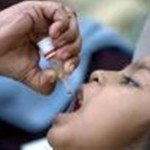Polio Symptoms in Children
 Polio virus is the cause of polio a highly contagious disease. The virus directly attacks the nerve cells in the brain and in the spinal cord. The nerve cells which are affected the most by this virus are those which control the muscles involved in movement and walking. If these neurons are destroyed, they lead to permanent paralysis and this happens in one out of 200 cases.
Polio virus is the cause of polio a highly contagious disease. The virus directly attacks the nerve cells in the brain and in the spinal cord. The nerve cells which are affected the most by this virus are those which control the muscles involved in movement and walking. If these neurons are destroyed, they lead to permanent paralysis and this happens in one out of 200 cases.
When a healthy child comes in direct contact with the particles of virus shed from the throat or faeces, he gets infected by the virus. A vaccine to prevent this dread disease was developed in the year 1955 and oral vaccine was developed in 1961. Due to proper dosage of vaccine administered in the developed world it has been fully eradicated, however as a result of efforts put in by world health organisation it is anticipated that the disease will be fully eradicated worldwide soon. Poor sanitation and poor hygiene are the main causes of spread of polio. In countries where polio has been fully eradicated inactive polio vaccine is used and in this case polio never infects.
Polio is of two types. These are:
- Minor poliomyelitis occurs in young children and more common of the two forms. In this case brain and spinal cord are not affected and the infection is milder. The patient suffers from fever, headache, sore throat and vomiting
- Major poliomyelitis is a severe form of polio and the symptoms start to appear in 10 to 14 days of contracting infection. The symptoms include fever, pain in back and neck and severe muscle pain. This is associated with abnormal feeling in the skin. The patient starts to suffer from muscle spasm and tends to retain urine. Associated with these symptoms muscle weakness of legs and symptoms of paralysis develop. The damage could also be caused to arms, abdominal and throat muscles also. Respiratory failure also occurs in some acute cases.
To diagnose existence of polio infection, neurological examination is done. In case the doctor finds that there are indications of muscle weakness along with fever, he will immediately proceed to test muscle reflexes, muscular contraction and decreased muscle tone. He will order lab test of stool and mucus from throat. He may also order blood test to get information about the antibodies to virus.
Children attacked by the minor polio virus recover. The process of recovery may be apparent in three days. The fever and other symptoms may be over very soon but the paralysis caused can be permanent. However, some muscle functions may return in six months and with treatment improvement can continue up to two years.
Prevention of polio with vaccine
Prevention is the best way to keep the child safe and immune from this dread disease which may affect the whole life of the patient. Depending upon the country or the place you live, immunisation programmes are developed and advertised to enable the parents to get the child immunised against polio. Generally polio vaccine is given by mouth, however in some cases it can be injected in the body of the child.
To reduce doses and number of visits to the doctor or clinic, combination vaccines are being developed. In case where there are instances of occurrence of polio in children repeat doses are given at periodic intervals. Even adults who have not been vaccinated earlier and have to travel to the infected areas should take two doses 6 to 12 months apart.
There is practically no drug which will help negate the effect of polio once the nervous system gets damaged and paralysis develops in the limbs. However to make the life of the patient easy and to increase mobility, physical therapy may be of help. The patient should be made to learn to walk with the aid of supports so that he is able to lead a normal life though with some restrictions. Do not forget a date with the polio vaccination programme at any time.